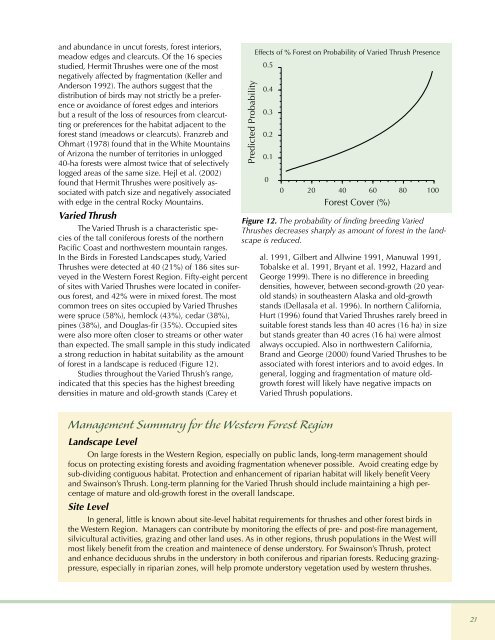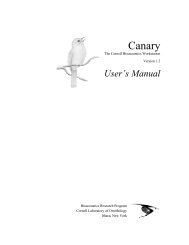A Land Manager's Guide to Improving Habitat for Forest Thrushes
A Land Manager's Guide to Improving Habitat for Forest Thrushes
A Land Manager's Guide to Improving Habitat for Forest Thrushes
Create successful ePaper yourself
Turn your PDF publications into a flip-book with our unique Google optimized e-Paper software.
and abundance in uncut <strong>for</strong>ests, <strong>for</strong>est interiors,<br />
meadow edges and clearcuts. Of the 16 species<br />
studied, Hermit <strong>Thrushes</strong> were one of the most<br />
negatively affected by fragmentation (Keller and<br />
Anderson 1992). The authors suggest that the<br />
distribution of birds may not strictly be a preference<br />
or avoidance of <strong>for</strong>est edges and interiors<br />
but a result of the loss of resources from clearcutting<br />
or preferences <strong>for</strong> the habitat adjacent <strong>to</strong> the<br />
<strong>for</strong>est stand (meadows or clearcuts). Franzreb and<br />
Ohmart (1978) found that in the White Mountains<br />
of Arizona the number of terri<strong>to</strong>ries in unlogged<br />
40-ha <strong>for</strong>ests were almost twice that of selectively<br />
logged areas of the same size. Hejl et al. (2002)<br />
found that Hermit <strong>Thrushes</strong> were positively associated<br />
with patch size and negatively associated<br />
with edge in the central Rocky Mountains.<br />
Varied Thrush<br />
The Varied Thrush is a characteristic species<br />
of the tall coniferous <strong>for</strong>ests of the northern<br />
Pacific Coast and northwestern mountain ranges.<br />
In the Birds in <strong>Forest</strong>ed <strong>Land</strong>scapes study, Varied<br />
<strong>Thrushes</strong> were detected at 40 (21%) of 186 sites surveyed<br />
in the Western <strong>Forest</strong> Region. Fifty-eight percent<br />
of sites with Varied <strong>Thrushes</strong> were located in coniferous<br />
<strong>for</strong>est, and 42% were in mixed <strong>for</strong>est. The most<br />
common trees on sites occupied by Varied <strong>Thrushes</strong><br />
were spruce (58%), hemlock (43%), cedar (38%),<br />
pines (38%), and Douglas-fir (35%). Occupied sites<br />
were also more often closer <strong>to</strong> streams or other water<br />
than expected. The small sample in this study indicated<br />
a strong reduction in habitat suitability as the amount<br />
of <strong>for</strong>est in a landscape is reduced (Figure 12).<br />
Studies throughout the Varied Thrush’s range,<br />
indicated that this species has the highest breeding<br />
densities in mature and old-growth stands (Carey et<br />
Management Summary <strong>for</strong> the Western <strong>Forest</strong> Region<br />
<strong>Land</strong>scape Level<br />
0.5<br />
0.4<br />
0.3<br />
0.2<br />
0.1<br />
Predicted Probability Effects of % <strong>Forest</strong> on Probability of Varied Thrush Presence<br />
0<br />
0 20 40 60 80 100<br />
<strong>Forest</strong> Cover (%)<br />
Figure 12. The probability of finding breeding Varied<br />
<strong>Thrushes</strong> decreases sharply as amount of <strong>for</strong>est in the landscape<br />
is reduced.<br />
On large <strong>for</strong>ests in the Western Region, especially on public lands, long-term management should<br />
focus on protecting existing <strong>for</strong>ests and avoiding fragmentation whenever possible. Avoid creating edge by<br />
sub-dividing contiguous habitat. Protection and enhancement of riparian habitat will likely benefit Veery<br />
and Swainson’s Thrush. Long-term planning <strong>for</strong> the Varied Thrush should include maintaining a high percentage<br />
of mature and old-growth <strong>for</strong>est in the overall landscape.<br />
Site Level<br />
al. 1991, Gilbert and Allwine 1991, Manuwal 1991,<br />
Tobalske et al. 1991, Bryant et al. 1992, Hazard and<br />
George 1999). There is no difference in breeding<br />
densities, however, between second-growth (20 year-<br />
old stands) in southeastern Alaska and old-growth<br />
stands (Dellasala et al. 1996). In northern Cali<strong>for</strong>nia,<br />
Hurt (1996) found that Varied <strong>Thrushes</strong> rarely breed in<br />
suitable <strong>for</strong>est stands less than 40 acres (16 ha) in size<br />
but stands greater than 40 acres (16 ha) were almost<br />
always occupied. Also in northwestern Cali<strong>for</strong>nia,<br />
Brand and George (2000) found Varied <strong>Thrushes</strong> <strong>to</strong> be<br />
associated with <strong>for</strong>est interiors and <strong>to</strong> avoid edges. In<br />
general, logging and fragmentation of mature oldgrowth<br />
<strong>for</strong>est will likely have negative impacts on<br />
Varied Thrush populations.<br />
In general, little is known about site-level habitat requirements <strong>for</strong> thrushes and other <strong>for</strong>est birds in<br />
the Western Region. Managers can contribute by moni<strong>to</strong>ring the effects of pre- and post-fire management,<br />
silvicultural activities, grazing and other land uses. As in other regions, thrush populations in the West will<br />
most likely benefit from the creation and maintenece of dense unders<strong>to</strong>ry. For Swainson’s Thrush, protect<br />
and enhance deciduous shrubs in the unders<strong>to</strong>ry in both coniferous and riparian <strong>for</strong>ests. Reducing grazingpressure,<br />
especially in riparian zones, will help promote unders<strong>to</strong>ry vegetation used by western thrushes.<br />
21

















